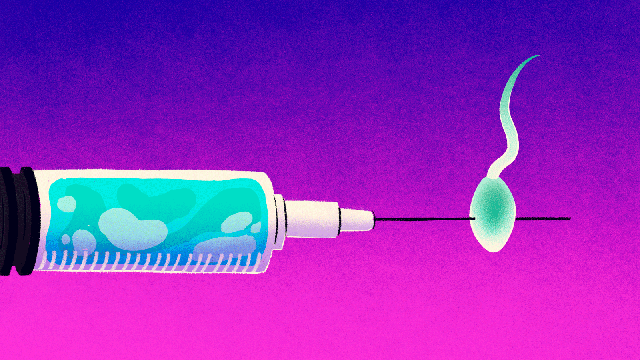A new form of male birth control, Vasalgel, is tantalisingly close to human trials — but we’ve heard that story before. Let’s take a look at some of the contraceptives for dudes that are languishing due to lack of funding.
Illustration by Angelica Alzona.
RISUG and Vasalgel
What is it? Vasalgel is a gel that can be injected (through the scrotum, it only hurts for a second, don’t be a baby) into the vas deferens, blocking sperm from swimming through. It doesn’t stop fluids, though, so a man who uses Vasalgel will have a sperm-free ejaculation. RISUG is a similar product that its makers say destroys, rather than blocks, sperm. Either way, the gel lasts for years, and can be reversed with a second injection.
First Developed: In India, in 1979.
Last Seen: RISUG’s Indian maker is applying for approval this year to sell the treatment in India. Vasalgel was shown to work in monkeys in a US-based trial this year, and could see human trials as early as 2018.
Why It’s Stalled: The FDA would need to see RISUG’s trials repeated in US-based tests before approving it in the US, and the Therapeutic Goods Administration (TGA) would need to approve it for it to be released in Australia. Vasalgel’s trials are being funded by a nonprofit because apparently pharmaceutical companies aren’t interested. They are asking for donations to fund trials.
The Progestogen/Testosterone Shot
What is it? An injection, every eight weeks (into your butt), of two hormones. One, a form of testosterone, reduces male fertility. And the other, a progestogen, makes the testosterone more effective so that you don’t need as large a dose.
First Developed: In the 1970s, although testosterone has been known to affect fertility since at least 1939.
Last Seen: In an almost-successful trial whose results were published in October 2016. The injections were 98 per cent effective at preventing pregnancy. Five per cent of the men didn’t get their fertility back, though, which is kind of a big downside.
Why It’s Stalled: That trial ended early because of side effects that included mood disorders and depression. Two of the study’s clinics were responsible for most of the concerning side effects, suggested that something weird was going on there. An ethics board decided that the study should be stopped. Despite a lot of backlash about the male participants being crybabies, 75 per cent of them said they liked the results and would be happy to keep using it if they could.
Gossypol
What is it? A chemical from cotton seeds. Men who eat food cooked in cottonseed oil have lowered fertility, so scientists investigated whether gossypol could make an effective birth control pill.
First Developed: In China in the 1970s.
Last Seen: In China in the 1980s, where researchers were trying to figure out how to reduce the chances of fatigue and paralysis, and if the men involved in the studies would ever be fertile again.
Why It’s Stalled: This drug’s side effects were deal-breakers. Some 20 per cent of men in the studies didn’t get their sperm production back, even two years after they stopped taking the pill. The drug also causes a dangerous shortage of potassium in the body, which causes the other scary symptoms.
The ‘Clean Sheets’ Pill
What is it? A drug men can take before sex, that stops the tiny muscles in the vas deferens from being able to squirt semen forward. The pill’s makers say an orgasm still feels the same, but nothing comes out. Bonus: That means you’re a lot less likely to transmit HIV.
First Developed: In the 1980s, based on observations from decades-old animal studies.
Last Seen: Blocking sperm in rams (you know, male sheep) in this study reported in 2011.
Why It’s Stalled: Again, lack of funding. The same nonprofit that’s pursuing trials of Vasalgel is working on this one, too, but they haven’t announced human trials yet.
Why Is It So Hard to Develop Male Birth Control?
For any drug to make it to market, the benefits have to outweigh the risks. Women already face risks from pregnancy, so birth control just has to be safer than having a baby. Men don’t have that same tradeoff, so even small risks can disqualify a treatment.
Besides, we already have other forms of birth control, so men who don’t want to make babies still have plenty of options. If condoms and women’s birth control didn’t exist yet, you can bet that male birth control would seem like a more urgent need. But men can just ask their partners to take a pill, and 52 per cent of them won’t even realise they benefit, too.
Finally, it isn’t easy to make a reversible birth control. Ideally, a birth control method is something that a person can use when they don’t want to have kids, and stop using when they’re ready to start a family. If a pill has a 20 per cent chance of making you permanently infertile, how likely are you to take that pill?
For all of these reasons, male birth control doesn’t look too profitable — which means drug companies aren’t interested in investing in it. Nonprofits that aim to bring birth control to the developing world are more focused on giving women the tools to control their own fertility, which you have to admit makes sense. So male birth control is a second choice, and not an urgent one. Which means it’s likely to be vaporware for years to come.

Comments